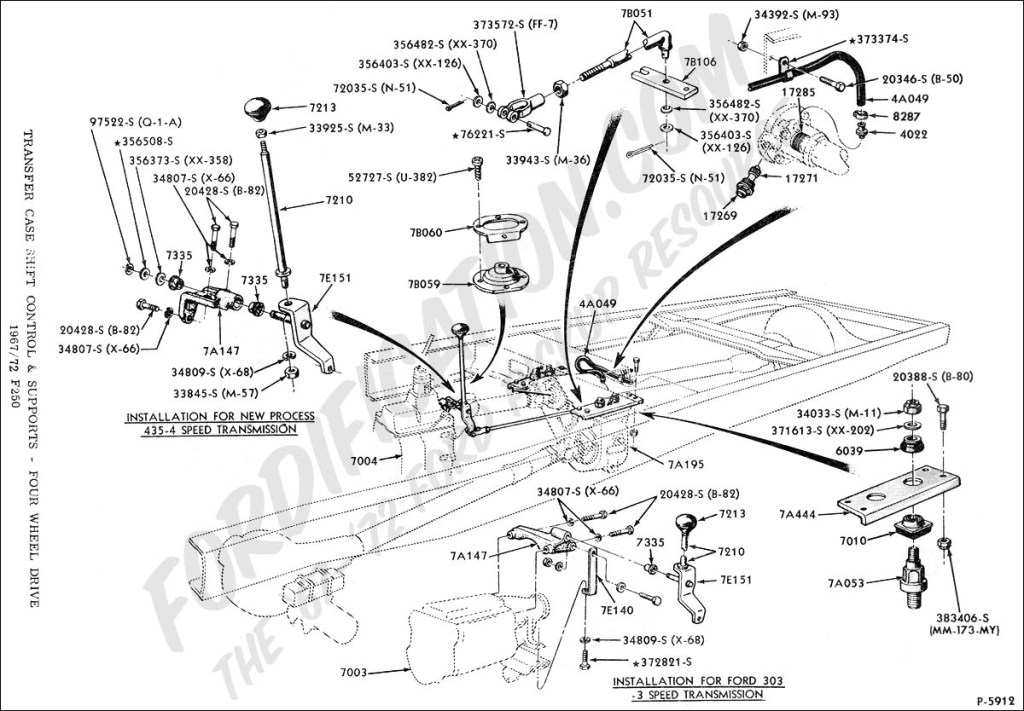Unlock The Power Of Your 1972 Ford F100 Manual Clutch Linkage: A Complete Guide
1972 Ford F100 Manual Clutch Linkage: A Comprehensive Review
Introduction
The 1972 Ford F100 is a classic truck that has stood the test of time. One of its essential components is the manual clutch linkage, an integral part of the vehicle’s transmission system. In this review, we will explore the various aspects of the 1972 Ford F100 manual clutch linkage and its significance for truck enthusiasts and owners alike. From its overall structure and organization to its functionalities and maintenance requirements, this article aims to provide a comprehensive overview of this crucial component.
2 Picture Gallery: Unlock The Power Of Your 1972 Ford F100 Manual Clutch Linkage: A Complete Guide
Body
What is the 1972 Ford F100 Manual Clutch Linkage?

Image Source: fordification.com
The 1972 Ford F100 manual clutch linkage is a mechanical system that connects the clutch pedal to the clutch release fork. It enables the driver to engage and disengage the clutch, allowing for smooth gear shifting and optimal control over the vehicle’s power delivery. This linkage consists of various components, including the clutch pedal assembly, push rod, Z-bar, pivot ball, clutch release fork, and return spring.
Who would benefit from the 1972 Ford F100 Manual Clutch Linkage?
Truck enthusiasts, collectors, and owners of the 1972 Ford F100 would greatly benefit from understanding the manual clutch linkage system. This knowledge empowers them to maintain the performance and longevity of their vehicles, ensuring a smooth driving experience and minimizing the risk of costly repairs. Mechanics and automotive technicians specializing in classic truck restoration would also find this information invaluable in their line of work.
When and where was the 1972 Ford F100 Manual Clutch Linkage introduced?

Image Source: fordification.com
The 1972 Ford F100 manual clutch linkage was introduced with the release of the 1972 Ford F100 model. This iconic truck was manufactured in different Ford factories around the United States, including locations in Kansas City, Michigan, and Kentucky. The manual clutch linkage was a standard feature in all 1972 Ford F100 models equipped with a manual transmission.
Why is the 1972 Ford F100 Manual Clutch Linkage important?
The manual clutch linkage plays a vital role in the overall operation of the 1972 Ford F100. It allows for smooth gear engagement and disengagement, ensuring precise control and preventing excessive wear on the transmission components. Proper maintenance and adjustment of the clutch linkage system can prolong the lifespan of the clutch assembly, resulting in improved performance and reduced maintenance costs for the owner.
How does the 1972 Ford F100 Manual Clutch Linkage work?
When the driver depresses the clutch pedal, it activates the push rod connected to the pedal assembly. The push rod, in turn, transfers the input force to the Z-bar. The Z-bar then pivots around the pivot ball, pushing the clutch release fork forward. As a result, the clutch release bearing disengages from the pressure plate, allowing the transmission to shift gears smoothly. Releasing the clutch pedal reverses this process, engaging the clutch and transmitting power to the drivetrain.
Frequently Asked Questions (FAQ)
Q: Can I upgrade the manual clutch linkage in my 1972 Ford F100?
A: Yes, there are aftermarket upgrades available for the manual clutch linkage in the 1972 Ford F100. These upgrades typically offer improved durability and performance, providing a smoother clutch operation and enhanced driving experience.
Q: How often should I adjust the clutch linkage?
A: It is recommended to adjust the clutch linkage every 6,000 to 10,000 miles or as needed. Signs of an improperly adjusted clutch linkage include difficulty shifting gears, clutch slippage, and excessive pedal effort.
Q: Can I perform the clutch linkage adjustment myself?
A: While some owners may choose to perform the adjustment themselves, it is advisable to seek professional assistance if you are not familiar with the process. Improper adjustment can lead to clutch damage or failure, resulting in costly repairs.
Transition Paragraph
Now that we have covered the fundamental aspects of the 1972 Ford F100 manual clutch linkage, let’s delve deeper into its key features, controls, functionalities, and maintenance requirements.
Key Features of the 1972 Ford F100 Manual Clutch Linkage
The 1972 Ford F100 manual clutch linkage boasts several noteworthy features that enhance its performance and durability. These features include:
1. Sturdy Construction
The clutch linkage components are manufactured using high-quality materials, ensuring longevity and reliability even under heavy use.
2. Adjustable Design
The clutch linkage system allows for precise adjustments, allowing owners to customize the clutch pedal feel and engagement point according to their preference.
3. Smooth Operation
The manual clutch linkage ensures smooth gear engagement and disengagement, minimizing gear grinding and improving overall driving experience.
Controls and Functionalities
The 1972 Ford F100 manual clutch linkage is operated through the clutch pedal, which is located on the driver’s side footwell. Depressing the clutch pedal activates the linkage system, disengaging the clutch and allowing for gear changes. Releasing the pedal engages the clutch, transmitting power to the drivetrain.
Proper clutch pedal operation requires a sufficient amount of pedal travel and smooth engagement. Regular lubrication of the linkage components is also essential to maintain optimal performance and prevent excessive wear.
Fluid Capacities and Maintenance
The 1972 Ford F100 manual clutch linkage does not require any specific fluid or lubricant. However, regular greasing of the linkage components is recommended to ensure smooth operation and prevent rust or corrosion. It is advisable to inspect and lubricate the clutch linkage during routine maintenance intervals or whenever signs of stiffness or binding are observed.
Additionally, owners should periodically check for any signs of wear or damage in the clutch linkage components, such as worn pivot balls or excessive play in the clutch release fork. Addressing these issues promptly can prevent further damage and ensure the longevity of the clutch linkage system.
Various Models and Technologies
The 1972 Ford F100 manual clutch linkage was a standard feature across various models and trim levels. Whether you own the base model or a higher-end variant, you can rest assured knowing that the clutch linkage system is designed to deliver consistent performance and durability.
While the 1972 Ford F100 manual clutch linkage does not incorporate advanced technologies, its simplicity and robustness make it a reliable and user-friendly system. The manual clutch linkage’s mechanical design ensures direct control and immediate response, making it a favorite among enthusiasts who appreciate the raw driving experience of classic trucks.
User-Friendly Features
The 1972 Ford F100 manual clutch linkage is designed with user-friendliness in mind. The clutch pedal’s placement and travel distance allow for comfortable operation, reducing driver fatigue during extended periods of driving. The adjustable design also enables owners to tailor the clutch engagement to their preference, enhancing the overall driving experience.
Additionally, the manual clutch linkage’s straightforward mechanical operation makes it easy to understand and maintain. Owners can perform basic maintenance tasks, such as lubrication and adjustment, with minimal technical knowledge or specialized tools.
Tire Maintenance
While the 1972 Ford F100 manual clutch linkage is not directly related to tire maintenance, proper tire care is crucial for overall vehicle performance and safety. Owners should regularly inspect their tires for signs of wear, maintain proper inflation pressure, and rotate them at recommended intervals. Ensuring that the tires are in good condition contributes to optimal traction, stability, and braking performance, complementing the capabilities of the clutch linkage system.
Interior and Exterior
The 1972 Ford F100’s interior and exterior design are classic representations of the era. The interior features a straightforward layout with essential controls easily accessible to the driver. The exterior design showcases the iconic Ford F100 styling cues, including a bold front grille, distinctive headlights, and a rugged yet sleek profile.
While the manual clutch linkage does not directly influence the interior or exterior aesthetics, it is an integral part of the overall driving experience. The smooth operation and precise control provided by the clutch linkage system contribute to the overall satisfaction of owning and driving the 1972 Ford F100.
Towing Capacities
The 1972 Ford F100 was a capable towing vehicle, and the manual clutch linkage played a vital role in its towing capacities. The clutch linkage’s robust design allowed for smooth engagement and disengagement, enabling precise control over the power delivery when towing heavy loads.
It is important to note that the 1972 Ford F100’s towing capacities vary depending on the specific model, engine, and axle configuration. Owners should consult the owner’s manual or contact a Ford dealership to determine the maximum recommended towing capacity for their particular vehicle.
Additional Resources
For owners seeking further assistance or information regarding the 1972 Ford F100 manual clutch linkage
This post topic: Manual


